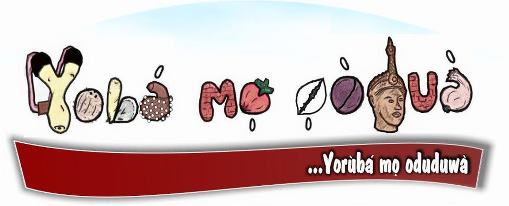* Ọmọ niyì, ọmọ nidẹ, ọmọ l’adé orí *
......................................................................................................
The ọjọ́ ìsọmọlórúkọ (day that a child is named) is 7 days ijọ́ keje after the birth of the child for a male child; fún ọmọ okùnrin, 9 days - ijọ́kẹẹ̀sán fún ọmọ obìrin for
a female child and 8 days for ìbejì (twin).
After the
birth of a baby; ọmọ, the mother is expected to stay indoors (ìyẹ̀wù), kí ó sì fún ọmọ lọ́yàn (breast feed the child ) with tender, love and care and not go outside till
the ọjọ́ìkómọjáde; the day the baby
will come out of the house for the first time.
Kó tó di ọjọ́yìí; before this day, the father of the child
would have consulted Ifá fún orúkọ tó dárajù fún ọmọ tuntun ọ̀hún; to get the best and most befitting name for his
child. But this is not applicable to all families.
Níjọ́ yẹn, obìrin àgbà ilé tàbí ìyálé-ilé yóó dami
sórí orùlé, wọ́n á sì fi
ara ọmọ náà gba
omi ọ̀hún; on that day,
the senior wife (ìyálé ilé) or the oldest woman in the house - ilé will
pour some water on the roof and will place the child under the roof for the
water to drop on baby.
Bí a bá ṣe eléyìí,
okùnrin àgbà ilé/baálé ilé
yó gba ọmọ náà láti ṣàlàyée bí a ṣe bí ọmọ - The
baby is now given to the head of the house (baálé ilé) who will
tell the story of the child including the father and mothers efforts before the
pregnancy, during pregnancy and after the birth of the child.
He will talk
of situations before the birth of the child and compare with situation after
the birth of the child. Also, the background story of the family where the
child is born, whether by a rich merchant; onísówo,
hunter; ọdẹ, farmer; àgbẹ̀, ruling family (ìdílé ọlọ́ba) respectively will surface at this gathering.
Along the
line, from the explanations of the baálé ilé, one can predict what the name of the child would likely be.
Lára àwọn èlò ìsọmọlórúkọ nílẹ̀ẹ Yorùbá nìwọ̀nyí:
· iyọ̀
· oyin
· ìrèké
.
ọtí
· àádùn
· omi
· orógbó
 |
| orógbó |
As the story
goes on, the head of the family picks the ìrèké; sugar cane, orógbó;
bitter kola, iyọ̀; salt, oyin; honey, omi tútù; water and gógóró; hot drink as well as any other sweet things that can be
eaten or of significance to the family respectively, bites a little, gives to
the child and says -
“Ọmọlábakẹ̀, gba orógbó, wa gbó bi orógbó se
gbó”
and all reply;
" àṣẹ́, àṣẹ́, àṣẹ́!!!"
 |
| ìrèké |
This is how
he will pick the iyọ̀, tastes it, puts in the babies mouth and say “Lábakẹ̀, iyọ̀ re o, aiye rẹ̀ a niyọ̀, a dùn bi ti iyọ̀, ki o dùro jẹ iyọ̀ náà pẹ o” and all answers amen, amen, amen!!!.
Next thing
is the oyin, he does the
same thing, saying -
“Lábakẹ̀ oyin rè é, dídùn ni
ti oyin, ayé ẹ á dùn
bí oyin o”, he does similar process with the ọtí, and will say “Ọmọlábakẹ̀, ọtí kì í tí,
o ò ní tí ”, response
from the audience will be, àṣẹ́!!!
The olórí ẹbí or baale ilé
picks all these symbolic items to usher in
the child to a good life, he taste it first puts in the child's mouth, pray for the child and passed the foods on
for other to have a taste of the good life too.
Omi- tútù ló kàn, gbogbo ènìyàn níkàlẹ̀ yó gbé ọmọ tuntun, olúkúlùkù yóó sàdúrà, yó sì fọwọ́ sínúu igbá omi yìí; water in a
calabash is next in the naming rite, everyone will carry the baby, prays for it
after which owó; money
will be dropped into this water placed at the centre of the house. The money is
to be used to purchase some items for the use of the child.
Everyone has prayed,
left to the baale ile to do the last prayer to ‘cement’ the whole process. “Ọlọ́run á dá a sí, ọlọ́run á wòó” he says.
It all ends here, Yoruba
food, palm wine, ogogoro, and Yoruba music thrills and entertainment guests,
and well wishers.
Have you witnessed any Yoruba naming ceremony? What did you see?
Check out www.yobamoodua.org for more on Yorùbá education and information.



No comments:
Post a Comment
Kí ni o ní sọ?